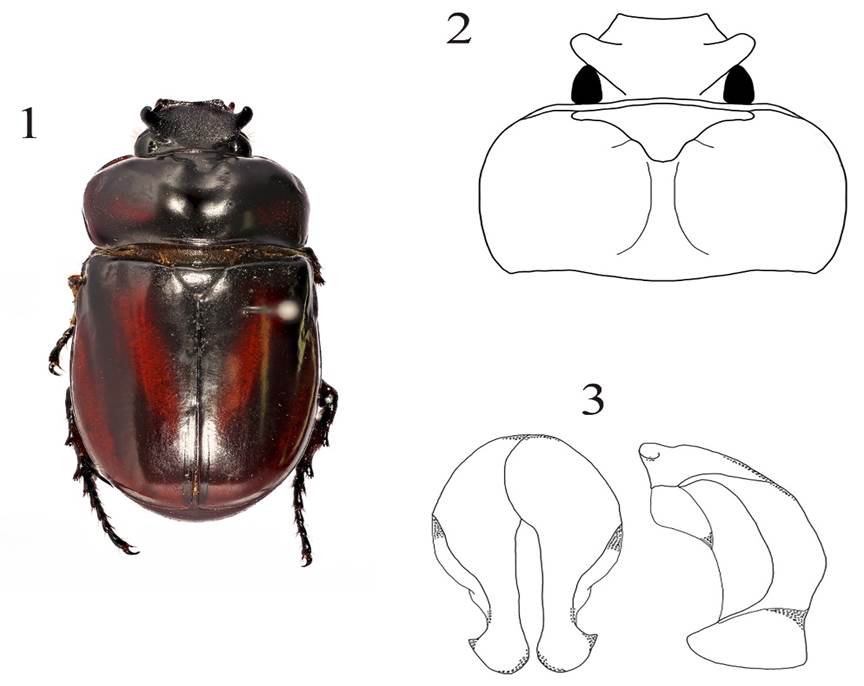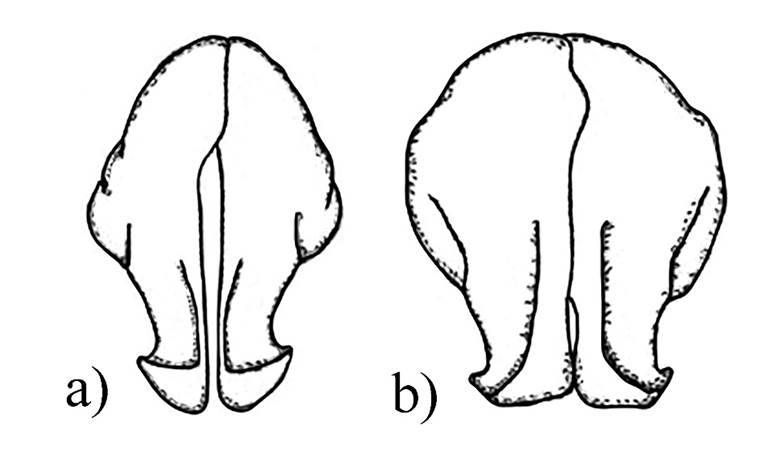Introduction
The genus Pucaya was described by Ohaus (1910) to accommodate a dynastine species with dubious tribal assignment, P. castanea Ohaus, 1910 based on specimens from Pucay and two other localities in southwestern Ecuador. During the six subsequent decades, three taxa were added to the genus, based on specimens from Colombia: P. pulchraArrow, 1911 (Arrow, 1911), P. castanea columbianaBeck, 1942 (Beck, 1942) and P. punctataEndrödi, 1968 (Endrödi, 1968).
In Endrödi´s contributions (1968, 1985), Pucaya was assigned to Pentodontini tribe, its distribution was extended to Central America and P. castanea columbiana was considered merely as a morphological variant without subspecies or variety rank. Ratcliffe (2003) offered a detailed re-description and distributional data for P. castanea in Costa Rica and Panama. López García et al. (2015) reviewed the genus including a key to species, re-descriptions, distributional data for Colombia and natural history notes, also finding morphological evidence to synonymize P. punctata with P. pulchra. Recently, Paucar-Cabrera and Moore (2018) transferred Pucaya from Pentodontini into Cyclocephalini based on morphological and molecular data, providing a new review with distributional data for Ecuador. According to most recent checklists and reviews, this genus has not been previously recorded in Peru (Ratcliffe et al., 2015; López-García et al., 2016; Paucar-Cabrera & Moore, 2018).
The objective of this paper is to describe a new species of Pucaya from Santuario Nacional Tabaconas-Namballe nature conservation area in northern Peru (Cajamarca), and include it into a key for the species of this genus.
Material and methods
During her research visit to Museo de Entomología Klaus Raven Büller - Universidad Nacional Agraria La Molina, Lima, Peru (MEKRB) in June 2018, Margarita López-García suggested to the author that Pucaya specimens housed in this entomological collection could belong to an undescribed species. This preliminary observation was verified with subsequent review of these specimens and comparison with published descriptions of previously known species.
Morphological terms of description, diagnosis and proposed key to species follow to most recent reviews of genus Pucaya (López-García et al., 2015; Paucar-Cabrera & Moore, 2018). Type specimens of the new species were deposited in MEKRB.
Type specimens were photographed with a Canon© EOS Rebel T5i DSLR, equipped with Macro lens and rail. Each image includes a series of photos taken in different planes, which were stacked with the Helicon focus 5.1 software. Parameres were extracted, treated for 10 minutes in 20% KOH, washed with distilled water and adhered to a small piece of cardboard. Drawings were done by the prints of photographs, observations with stereomicroscope and digital improving with a graphic design software. Label data for the new species is quoted verbatim; different lines of the label are separated by a diagonal slash (/) and different labels are indicated by brackets ([ ]). Distributional map was prepared using SimpleMappr (Shorthouse, 2010).
Results
Pucaya tabaconas Giraldo, new species (Fig. 1, 2, 3)

Figures 1-3 Pucaya tabaconas sp. nov: 1) Holotype habitus, 2) Head and pronotum, 3) parameres, caudal and lateral views.
Type material
Holotype (male): [PERU, Cajamarca, San Ignacio/Miraflores, El Sauce/1500 m, 05°10′23.3″S/79°16′48.7″W/16-Abr-03, Col. R. Acosta] [Sant. Nac. Tabaconas/Namballe, Bosque/húmedo premontano/trop. colecta manual]. Paratype (male) with the same labels.
Description
Habitus (Fig. 1). Length 30 mm, width 14 mm. Coloration, black background with reddish brown marks on disk and lateral surfaces of pronotum and elytra; venter dark reddish brown; head, tibiae and tarsi black.
Head. Clypeus trapezoidal, with apex very broadly truncate, shallowly emarginated, with anterior and lateral margins upturned, rough surface with scaly appearance. Frontoclypeal suture absent. Frons flat, rough surface with scaly appearance, with two vertically raised horns. Interocular distance equals four times the transverse ocular diameter. Eye canthus with three apical erect setae. Antenna with 10 antennomeres arranged as follows: 1 elongate with thickened apex, 2-7 short, 8-10 forming a club slightly longer than 2-7 joined. Mandibles small and slender, hidden below clypeus.
Pronotum. Surface smooth with minute, sparse punctures. Apex with a large central transversal depression incised until middle of pronotal disk. Lateral protuberances at both sides of depression, each one with a cusp near to midline (Fig. 2). Anterior margin, lateral margins and base with marginal bead, bead obsolete in one fourth of basal length adjacent to each posterior angle. Scutellar surface with a few minute punctures.
Elytra. Surface smooth with minute, sparse punctures; punctures becoming denser along humeral area and lateral margins. Elytral suture noticeable on apical third.
Pygidium. Surface smooth with minute, sparse punctures; convex in lateral view; apical margin clothed with a rim of long yellow setae.
Legs. Protibia tridentate, two adjacent apical teeth and basal tooth removed from others. Protarsus enlarged, larger claw with apex incised. Metatibial apex crenulate, with 11 spinules. Apex of first meta-tarsomere triangularly elongated.
Venter. Prosternal process short, not projecting beyond procoxa; apex transversely oval, anterior 2/3 convex, posterior 1/3 flat, anterior and posterior parts separated by a sulcus; clothed with long yellow setae. Mesosternum and Metasternum surfaces densely punctuated; clothed with a dense cover long yellow setae. Abdominal sternites scarcely punctuated, glabrous.
Parameres (Fig. 3). In caudal view, slightly asymmetrical, apices not dilated and rounded, with lateral teeth not separated from distal end. In lateral view, blunt apex and lateral tooth (as a small tubercle) are visible.
Variation. Male paratype is smaller (length 25.3 mm, width 11.5 mm), with reddish brown marks somewhat vanished under black color, venter darker, shorter frontal horns, pronotal protuberances less developed, elytral suture basally disaggregated into punctures and apex of metatibia with 12 spinules. Female unknown.
Diagnosis. P. tabaconas is recognized by medium to large body size (25-30 mm), antennal club longer than antennomeres 2-7, pronotal protuberances well developed, elytra with disperse minute punctures and impressed sutural stria on apical third, apex of metatibia with 11-12 spinules and parameres with lateral teeth of apices not separated from distal end by a carina.
Distribution and habitats. Known only from type locality (Fig. 4). According to label data, vegetation is tropical pre-montane moist forest, and specimens were collected by hand collecting. In comparison, P. castanea inhabits montane forests or coffee crops, while P. pulchra has been found in more opened habitats as grasslands, reeds o banana crops (Ratcliffe, 2003; López-García et al., 2015).

Figure 4 Known distribution of Pucaya species in Central and South America. Approximate distribution of P. castanea and P. pulchra based on data available in Ratcliffe (2003), López-García et al. (2015) and Paucar-Cabrera & Moore (2018).
Etymology. The specific name alludes to the nature conservation area where the type specimens were collected.
Previous keys to species of genus Pucaya should be modified in the following way for to include the new species
1. Size medium (20.0-24.0 mm). Pronotum with protuberances scarcely developed. Elytra striate-punctate on basal 2/3 length and impressed sutural stria at least on apical half. Apex of metatibia with 14-17 (rarely 12) spinules. Parameres with apices dilated, lateral teeth absent (Fig. 5a). . . . . . . . . . . . . . . . . . . . . . . . . . . . . . . . . . . . . . . . . . . . . . . . . . . . . . . . . . . . . . . . . . . . . . . . . . . . . . . . . . . . . . . . Pucaya pulchra Arrow

Figure 5 Parameres of Pucaya species in caudal view: a) P. pulchra, b) P. castanea. Redrawn of López-García et al. (2015).
-Size medium to large (23.0-32.5 mm). Pronotum with protuberances well developed. Elytra smooth with disperse minute punctures and impressed sutural stria at most on apical third. Apex of metatibia with 9-12 spinules. Parameres with apices not dilated, lateral teeth present. . . . . . . . . . . . . . . . . . . . . . . . . . . . . 2
2. Antennal club shorter than antennomeres 2-7. Elytra without impressed sutural stria on entire length. Apex of metatibia with 9 spinules. Parameres with lateral teeth of apices separated from distal end by a carina (Fig. 5b).. . . . . . . . . . . . . . . . . . . . . . . . . . . . . . . . . . . . . . . . . . . . . . . . . . . Pucaya castanea Ohaus
-Antennal club longer than antennomeres 2-7. Elytra with impressed sutural stria on apical third. Apex of metatibia with 11-12 spinules. Parameres with lateral teeth not separated from distal end (Fig. 3).. . . . . . . . . . . . . . . . . . . . . . . . . . . . . . . . . . . . . . . . . . . . . . . . . . . . . . . . . . . . . . . . . Pucaya tabaconas sp. nov.











 text new page (beta)
text new page (beta)


